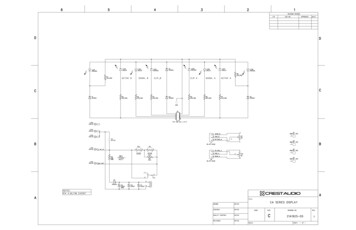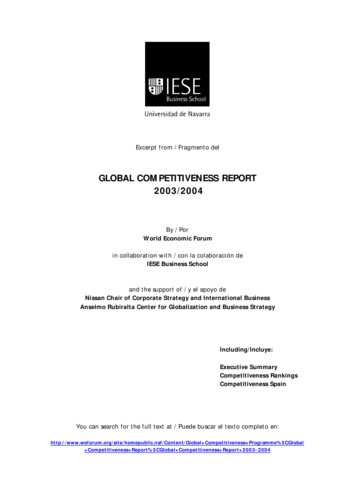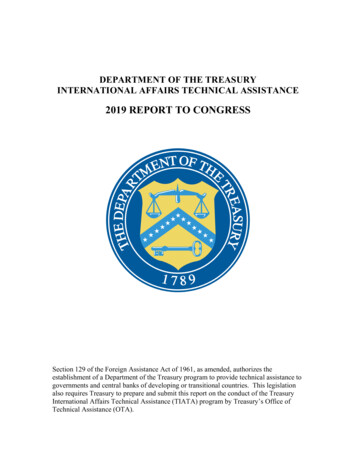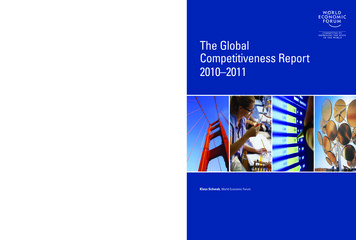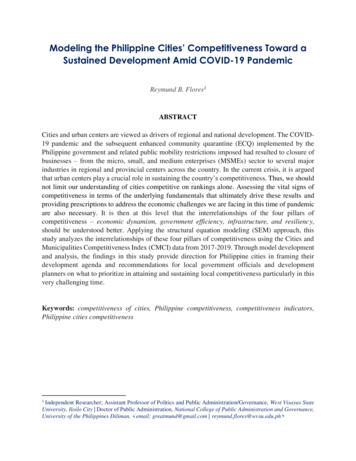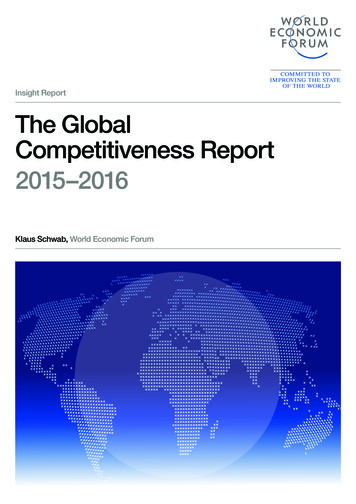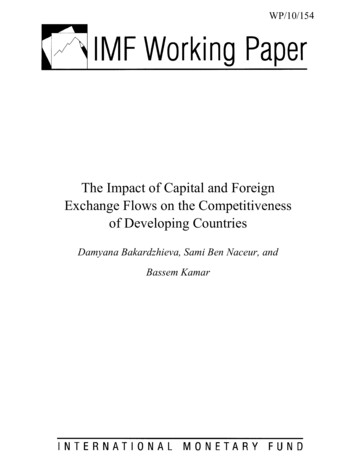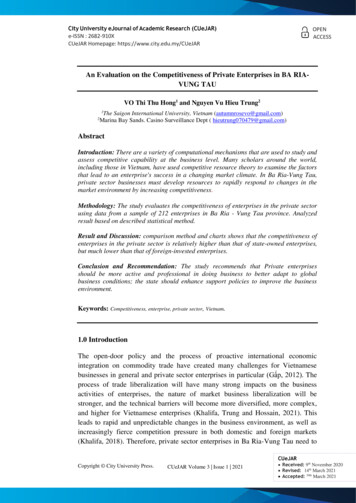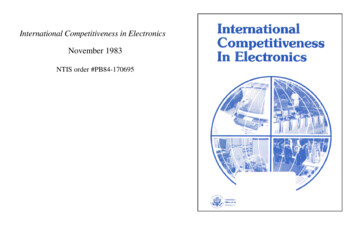
Transcription
International Competitiveness in ElectronicsNovember 1983NTIS order #PB84-170695
Recommended Citation:International Competitiveness in Electronics (Washington, D. C.: U.S. Congress, Officeof Technology Assessment, OTA-ISC-200, November 1983).Library of Congress Catalog Card Number 83-600610For sale by the Superintendent of Documents,U.S. Government Printing Office, Washington, D.C. 20402
ForewordThis assessment, requested by the Senate Committee on Commerce, Science,and Transportation, the House Committee on Ways and Means, and the Joint Economic Committee, completes a series of three reports on the competitiveness ofU.S. industries. The series began with Technology and Steel Industry Competitiveness and continued with U.S. Industrial Competitiveness: A Comparison of Steel,Electronics, and Automobiles.Today, the subject of international competitiveness has more visibility amongthe general public than ever before. It has emerged as one of the primary economicissues facing Congress. Debates over “reindustrialization” and “industrial policy”beginning several years ago have been renewed. This assessment continues OTA’sexploration of the meaning of industrial policy in the U.S. context, while also examining the industrial policies of several of our economic rivals.Electronics virtually defines “high technology” in the 1980’s. This assessmentsets the characteristics of the technology itself—a technology already of such ubiquity that microprocessors and computers outnumber people in the United States—alongside other forces that exert major influences over international competitiveness. These factors range from human resources and costs of capital to thepriorities that corporate managers place on manufacturing technologies and thequality of their products. The report concludes by outlining five options for a U.S.industrial policy, drawing on electronics for examples of past and prospective impacts, as well as on OTA’s previous studies of the steel and automobile industries.OTA is grateful for the assistance of the advisory panel for this assessment,as well as for the help provided by many individuals in other parts of the FederalGovernment. OTA assumes full responsibility for the report.Director.///
Electronics Advisory PanelKatherine Seelman, ChairpersonNew York, N. Y.Jack C. ActonGreensburg, Pa.Steve BeckmanAFL-CIOA. Terry BrixRichard A. KraftMatsushita Industrial Co.E. Floyd KvammeApple Computer Inc.Geraldine McArdleTemar Ltd.Reston, Va.Richard P. CaseCharles PhippsIBM Corp.Ruth Schwartz CowanSUNY-Stony BrookWilliam Kay DairiesAmerican Retail FederationLeonard DietchZenith Radio Corp.Isaiah FrankJohns Hopkins UniversityF. Willard Griffith IIGC InternationalRobert R. JohnsonMosaic Systems Inc.Texas Instruments, Inc.K. M. PooleBell LaboratoriesBenjamin M. RosenSevin Rosen Management Co.Kate WilhelmEugene, Oreg.Robert B. WoodInternational Brotherhood of ElectricalWorkersMichael Y. YoshinoHarvard Business School
International Competitiveness in Electronics Project StaffLionel S. Johns, Assistant Director, OTAEnergy, Materials, and International Security DivisionPeter Sharfman, Program ManagerInternational Security and Commerce ProgramJohn A. Alic, Project DirectorMartha Caldwell HarrisRobert R. Miller*ContributorsRobert Fisher*Robert Rarog*Phillip Otterness*Barbara Sachs*ContractorsL. W. Bergman & Co.Princeton, N.J.Mary Ann MaguireUniversity of Maryland, College ParkConsultant Services Institute, Inc.Livingston, N.J.Mitsubishi Research Institute, Inc.Tokyo, JapanDeveloping World Industry &Technology, Inc.Washington, D.C.Richard W. MoxonUniversity of Washington, SeattleSterling Hobe Corp.Washington, D.C.Hamilton Herman, et al.Potomac, Md.John H. Wheatley, et al.University of Washington, SeattleH. C. LinUniversity of Maryland, College ParkOTA Publishing StaffJohn C. Holmes, Publishing OfficerJohn BerglingKathie S. BossGlenda Lawing* O T A ( ontra[ t p( rwnnelDebra M. DatcherLinda A. LeahyJoe HensonCheryl J. Manning
ContentsChapterPage1. Part A: Summary . . . . . . . . . . . . . . . . . . . . . . . . . . . . . . . . . . . . . . . . . . . . . . . . 3Part B: Extended Summary . . . . . . . . . . . . . . . . . . . . . . . . . . . . . . . . . . . . . . 232. Introduction . . . . . . . . . . . . . . . . . . . . . . . . . . . . . . . . . . . . . . . . . . . . . . . . . . . . 553. Electronics Technology . . . . . . . . . . . . . . . . . . . . . . . . . . . . . . . . . . . . . . . . ,. 674. Structure and Trade in the International Electronics Industry ., .,., 1075. Competitiveness in the International Electronics Industry . . . . . . . . . . . 1636. Manufacturing: Quality, Reliability, and Automation , . . . . . . . . . . . . . . . 2177, Financing: Its Role in Competitiveness in Electronics . . . . . . . . . . . . . . . 2538. Human Resources: Education, Training, Management . . . . . . . . . . . . . . . 3019. Employment Effects . . . . . . . . . . . . . . . . . . . ., . . . . . . . . . . . . ., . . . . . 34310. National Industrial Policies . . . . . . . . . . . . . . . . . . . . . . . . . . . . . . . . . . . . . . 37711. U.S. Trade Policies and Their Effects . . . . . . . . . . . . . . . . . ., . . . . . . . . 42912. Federal Policies Affecting Electronics: Options for the United States . . 463Appendix A: Glossary . . . . . . . . . . . . . . . . . . . . . . . . . . . . . . . . . . . . . . . . ,,.,. 505Appendix B: Offshore Manufacturing . . . , ., . . . . . . . . . . . . . . . . . . . . . . . . 510Appendix C: Case Studies in the Development and Marketingof Electronics Products .,. . . . . . . . . . . . . . . . . . . . . . . . . 520Index . . . . . . . . . . . . . . . . . . . . . . . . . . . . . . . . . . . . . . . . . . . . . . . . . . . . . . . . . . . . 539vii
CHAPTER 1Part A: Summary
ContentsPrincipal FindingsU.S. Competitiveness in Electronics . . . . . . . . . . . . . . . . . . . . . . . . . . . . . . . . . . . . . . . . .The Role of Technology . . . . . . . . . . . . . . . . . . . . . . . . . . . . . . . . . . . . . . . . . . . . . . . . . . .Industrial Policy . . . . . . . . . . . . . . . . . . . . . . . . . . . . . . . . . . . . . . . . . . . . . . . . . . . . . . . . . .Policy Concerns in Electronics . . . . . . . . . . . . . . . . . . . . . . . . . . . . . . . . . . . . . . . . . . . . .55779The Competitive Position of the U.S. Electronics Industry . . . . . . . . . . . . . . . . . . . .Consumer Electronics . . . . . . . . . . . . . . . . . . . . . . . . . . . . . . . . . . . . . . . . . . . . . . . . . . . . .Semiconductors . . . . . . . . . . . . . . . . . . . . . . . . . . . . . . . . . . . . . . . . . . . . . . . . . . . . . . . . . .Computers . . . . . . . . . . . . . . . . . . . . . . . . . . . . . . . . . . . . . . . . . . . . . . . . . . . . . . . . . . . . . . .Conclusion . . . . . . . . . . . . . . . . . . . . . . .0.00,.0 .00.0.0 . 0 . 0 . . .11111315****o*.*o*oo. e**o*** .*o.*o*.eo. .o*o*.* *****.******.00.00. .0.019TablePageU.S. Sales and Imports of Selected Consumer Electronic Products, 1982. . . . . . . . . . 12List of FiguresPageSales Trends in the U.S. Electronics Market . . . . . . . . . . . . . . . . . . . . . . . . . . . . . . . . . .U.S. Exports and Imports of Computers and Equipment . . . . . . . . . . . . . . . . . . . . . . .Semiconductor Production in the United States and Japan . . . . . . . . . . . . . . . . . . . . . .Increase in Capital Costs for High-Volume Integrated Circuit Production Line . . . .Price Index for Televisions Compared to All Consumer Durable . . . . . . . . . . . . . . . .Market Segmentation of U.S. Computer Sales by Value . . . . . . . . . . . . . . . . . . . . . . . .Japanese Production, Imports, and Exports of Computers and EquipmentIncluding Production and Exports of U.S.-Owned Subsidiaries . . . . . . . . . . . . . . . .35611121618
CHAPTER 1Part A: Summaryness of industries like electronics? Does theUnited States need a more coherent industrialpolicy?Is the United States in danger of losing, tothe Japanese or others, in the race to developnew high-technology electronics products—fifth-generation computers, high-density integrated circuits, pocket televisions? Does the decline of the American consumer electronics industry prefigure that of semiconductors orcomputers? Is U.S. standing in world marketsdeteriorating because of poor management,slipshod Government policymaking, overregulation of business? Will work in automobileproduction or heavy industry be permanentlyreplaced by high-technology jobs fewer in number and paying wages at half the level of the 15 to 20 per hour earned by auto or steelworkers? To what extent can electronics standfor other technology-based U.S. industries?Which policies of the Federal Government aremost crucial to the international competitiveSales Trends in theThese questions and others like them are addressed in this report, which covers three portions of the industry: consumer products (primarily color television); semiconductor devicessuch as integrated circuits; and computers. Thefocus of the report is the United States, but considerable attention goes to the electronics industries of Western Europe and Japan, as wellas several of the newly industrializing countries.Electronics in total employs more than amillion and a half Americans; 1982 sales exceeded 125 billion—roughly one-fifth of totalU.S. durable goods output—and have beenU.S.Electronics MarketITotal195519601965197019751980YearSOURCE E/ecfronicsMarket Data Book 1982 (Washington, D C Electronic Industries Association, 1982), p 43
4 International Competitiveness in Electronicsgrowing at nearly 15 percent per year; the sector is an export leader, with a surplus of about 3 billion on a total trade volume of nearly 50billion. The industry’s products feed manyother portions of the U.S. economy. Not onlydoes the Nation’s defense depend heavily onelectronic technologies, but both manufacturing and service industries—ranging from theproduction of numerically controlled machinetools to banking and insurance—use electronicproducts both directly and indirectly.The competitiveness of firms and industriesrefers to the ability of firms in one country todesign, develop, manufacture, and market theirproducts in competition with firms and industries in other countries. At several pointsbelow, shares of the U.S. market or of worldmarkets are used as examples of trends in international competitiveness; in fact, however,competitiveness is a more subtle concept.While market share is one possible indicator,it is only indirectly related to competitiveness,How an industry will fare in internationalcompetition depends on factors ranging fromtechnology itself, to industrial policies pursuedby national governments, to the human resources—technicians to upper-level managers—available in a given country. In somecases, competitiveness is primarily a functionof prices, hence manufacturing costs—themselves determined by wage rates, labor productivities, the design of both products and manufacturing processes. This is the case in consumer electronics. In higher technology portions of the industry, one firm may be able tooffer products that are beyond the technicalcapabilities of its rivals—e.g., high-density integrated circuits, advanced computer software.Where this is true, costs are less important.From the Federal perspective, shifts in theinternational competitiveness of American industries have ramifications far beyond mattersof trade balances and foreign economic policy,even military security. The competitive standing of a nation’s industries will determine quitedirectly its gross domestic product, and therefore the standard of living of its citizens.The linkage between competitiveness andemployment—in the aggregate, in particularsectors, or in particular occupational categories—is much looser. Industries can rise incompetitiveness while declining in employment—the case in the U.S. textile industry inrecent years. In other cases, competitivenessmay remain high, output may expand, but domestic employment may grow relatively slowlycompared to output; this has been the case inboth the U.S. semiconductor and computer industries. Similarly, domestic employment isonly loosely related to trends in foreign investment or to government policies directed at controlling flows of imported goods; trade protection has helped the employment picture in theU.S. consumer electronics industry no morethan it has in the steel industry or the automobile industry.While the competitiveness of a given sectorof the U.S. economy depends on both domesticand international economic forces, the domestic context—e.g., people and institutions here,not overseas—generally carries the most weightin determining which industries will grow incompetitiveness, which decline. As a result,public policies with domestic objectives exertthe most influence over trends in internationalcompetitiveness. These are matters of indus-trial policy. OTA uses this term in a neutralsense to refer to the body of regulations, laws,and other policy instruments that affect the activities of industry and the resources, includinghuman capital, that the Nation’s economy depends on. The United States has not in the pasthad a self-conscious industrial policy, in partbecause it had no need for one. The lesson ofthe U.S. electronics industry, along with industries like steel and automobiles that OTA hasexamined previously, is that future international competitiveness may well depend on a morecoherent and consistent approach by the Federal Government to matters of industrial policy,
Ch.1—Part A: Summary 5.—Principal FindingsThis is not to say that there is little cause forconcern, or that the waves of publicity giventhe progress made by Japan’s electronics manufacturers over the past few years have in allcases been overdramatized. If the U.S. electronics industry is still strong when comparedto other domestic industries, its margins withrespect to electronics industries in other nations have shrunk, in some cases vanished.Moreover, the Japanese electronics industry isone of the most productive in that nation’seconomy; this high standing relative to otherdomestic sectors is a major reason for the export strength of Japan’s electronics manufacturers. In almost all categories of electronicsproducts—office copiers and typewriters, mi-U.S. Competitiveness in Electronics1. Electronics remains a leader among American industries. High-technology firms—including those making microelectronic devices likeintegrated circuits and complex electronic systems such as computers—continue to be leading exporters, second to none in technology aswell as most measures of commercial success.Although the Nation’s imports of semiconductor products exceeded its exports for the firsttime in 1982 (by 160 million out of 3.8 billionin imports) more than three-quarters of theseimports were shipments by American-ownedfirms; computer exports ( 9 billion in 1982) farexceed imports.2YearSOURCES 1960-86-Gaps IrI Tectrnology Elecfronfc Computers (Paris Organization for Economic Cooperation and Development,1969), p 50.1967-81 — 1972, 1977, 1980, 1982 editions, U.S. Industrial Outlook, Department of Commerce1982-U.S. Department of Commerce, Bureau of Industrial Economics
6 International CompetitivenessinElectronicstechnology is certainly less than even half adozen years ago. American-owned firms mak-croelectronics, communications equipmentand consumer goods—the U.S.-Japan trade balance is strongly negative (see ch. 4).ing and selling semiconductor devices havefaced increasingly intense competition fromJapanese manufacturers, again primarily over2. Just as the competitive positions of a nation’s industries will differ, with some risingand others declining, so competitive positionswithin an industry like electronics will vary.Likewise, within one portion of the industry,such as color television manufacturing, somefirms will at any given time be more competitive than others.the last half-dozen years; although they havelost market share both at home and abroad insome key products—e.g., computer memorychips—their overall position remains strong.3. It is not realistic to expect that Americansemiconductor and computer firms will, in thenear future and in the absence of cataclysmicchanges in other parts of the world, return tothe preeminent positions they held at the beginning of the 1970’s. Nor can the United StatesWithin the U.S. electronics industry, competitiveness in consumer products has declinedprecipitously since the 1960’s. The Nation nowimports many of its consumer electronic products, while more than 10 foreign-owned firmsassemble and market television sets within theUnited States. In contrast, there are few signsexpect to achieve the technological and commercial leads of earlier years in other hightechnology industries. The capabilities of othercountries have improved; foreign electronicsindustries have risen within their own econo-of slackening competitiveness in the manufacture of computers, although the U.S. lead in5000 4,000 -A3,000 –2,000 –A1000 -1967 1968SOURCES:1969 19701971Un/tod St8t08-l!M7.76-A Report on the arSerrr/corrductor /ndustry (Washington, D. C.: Department of Commerce, September 1979), p. 39.f9T740-Surnrnary of Trade and Tar/ff h?formatlor?: Serrr/cork7uctors (Washington, D. C,: US International Trade Commission Publication841, Control No. 8-5-22, July 1982), p. 28.IMI, 1982—19S3 U.S. /rrdustr/a/ Out/ook (Washington, DC.: Department of Commerce, January 1983), p. 29-7.Japan—1967.80-Japan Fact Book ’80 (Tokyo: Dempa Publlcatlons, Inc.l 1980), p. 188; Japarr Electronics A/rnarrac(Tokyo: Dempa Publications, Inc.,1982), pp. 149, 178.ffMJf, 7MZ-/r? tat Electronics Reports Feb. 21, 1983, p. 5.19S2
Ch. 1—Part A: Summarymies; international economic conditions havechanged.4. The United States can continue to behighly competitive in electronics and othertechnologically driven industries, with U.S.firms remaining leaders in innovation, in international trade, and in sales and profits athome and abroad. Not only is this possible, itis necessary if the United States is to maintainits standard of living, its military security, andif the U.S. economy is to provide well-payingand satisfying jobs for the Nation’s labor force.Electronics is indispensable to a broad rangeof manufacturing and service functions, fromcomputer-aided design of the structures of office buildings to the switching of the telephoneswithin those buildings,5. Congress could take the initiative in devising programs that would actively support theelectronics industry, and others of comparableimportance. The first requisite is broad national agreement on the role of high-technologysectors like electronics as a driving force forfuture economic growth, a greater degree ofconsensus on where the U.S. economy is nowheading and where it should head. The secondis better understanding of how particularpieces of legislation affect the competitivenessof American industry, which in turn requiresdeveloping the capability of the Federal Government for analyzing the sources of competitive strength. 72. Superior product technologies may command premium prices in the marketplace, making manufacturing costs less significant. Prod-uct features—ranging from appearance toquantifiable characteristics such as the performance of a computer system in running“benchmark” programs—can contribute tocompetitive advantage; in high-technologyfields as in low, product differentiation andastute marketing can be important.Understanding customer wants and needs isvital to designing successful products; integrated circuits that are functionally similar,perhaps even interchangeable, may be differentiated through subtle variations in performance; advertising strategies can be built aroundclaims of high quality or rapid delivery; a broadarray of alternate source suppliers may reassure prospective purchasers. Manufacturersof computers and peripherals devote considerable effort to industrial design and humanfactors engineering; ease of use is vital in selling computer systems to first-time customers,Rapid technical change creates much morescope for product technology as a competitiveweapon in microelectronics and computersthan in consumer electronics. For many years,American semiconductor and computer manufacturers prospered by offering products thatfirms elsewhere in the world could not designor build.Industrial PolicyThe Role of Technology1. One way to establish a competitive advan-tage in an industry like electronics is throughsuperior technology. Better process technology—e.g., automation—can help reduce costs. Forsimilar products, lower manufacturing costspermit lower selling prices, hence a more competitive product. Alternatively, higher profitsmay be possible, which can help finance further improvements. Production technologiesare particularly important in consumer electronics and semiconductors, less so for largecomputers.1. OTA takes industrial policy to be a neutralterm referring to the group of Federal policiesthat affect competitiveness, productivity, andeconomic efficiency—sometimes directly,sometimes through influences on business decisions or on individuals. Industries rise andfall in international competition for many reasons. Seldom can single causes be found—moreseldom yet simple, straightforward policyremedies. Plainly, industrial policy offers noquick fixes for the dilemmas of the U.S. consumer electronics industry, nor any sure prescriptions that can guarantee the future com-
8 International Competitiveness in Electronics——the game. In the United States and in otherparts of the world, business enterprises compete in an environment shaped to considerableextent by government industrial policies (including elements of fiscal, monetary, tax, manpower, trade, and regulatory policies).*.Photocred/t: Mostek Corp.Portion of a read-only integrated circuit memorypetitiveness of our microelectronics or computer sectors. Just as plainly, competitiveness inelectronics—and in other U.S. high-technologyindustries—will depend on factors including: capable people, hence on Federal policiesdealing with education and training;capital for new business startups and forexpansion, hence on macroeconomic andtax policies;open markets for American products,hence on foreign economic policy; andthe research base that supports domesticfirms, hence on Federal technology andscience policy.The job of industrial policy is to evaluate, link,and coordinate the many Federal efforts thatdeal with such concerns.2. While international competitiveness isfirmly rooted in the efforts of private companies, public policies set many of the rules ofForeign governments are experimenting withindustrial policies intended to aid and supporttheir own electronics industries; virtually allindustrialized and industrializing nations single out electronics for special treatment. American firms seeking to export or to manufactureoverseas must contend with economic andsocial policies of host governments that aremore complex and sophisticated than in thepast. Rather than outright protectionism orother forms of overt discrimination against foreign firms, host governments now adopt indirect subsidies for their own industries—tax incentives, capital allocations, funding for commercially oriented research and development(R&D). At the same time, governments bargainwith foreign multinationals using carrots andsticks such as investment incentives and performance requirements while seeking to acquire jobs and technology, or to improve theirbalance of payments.3. Although a well-designed and supportiveindustrial policy is not, by itself, sufficient tobuild competitiveness in a given sector of a nation’s economy, government policies can, under some circumstances, tip the balance. TheUnited States can expect no more than verylimited success in negotiations with other nations aimed at minimizing the impacts of thosecountries industrial policies.For this and other reasons, a “business-asusual” approach is unlikely to prove sufficientto the task of maintaining U.S. competitivenessin electronics, Better prospects for strengthening the U.S. position would come with theadoption of more effective industrial policiesof our own. The American electronics industryfaces only a few major problems, mostly in thetrade arena, that are directly susceptible toGovernment remedy. On the other hand, Federal agencies could support the industry—directly and indirectly–in many ways. Few of
—.these would have much visibility. By the sametoken, they would not necessarily cost much.Consistent and careful attention to the manysmaller matters that affect competitiveness—diffusion of technology within the UnitedStates, tax treatment of equipment contributions to universities, the antitrust environmentfor joint R& D , long-term basic research—arethe necessary ingredients in a more coherentand productive industrial policy. A supercomputer project, to take a current example, maybe glamorous as well as desirable in itself, butis no substitute.4. The choice of policy tools, and the designof individual measures, depend on overall objectives; an industrial policy is the sum of manyparts that can be put together in different ways,Should Congress wish to pursue a more focused industrial policy for the United States,it could choose from among five broad alternatives:A protective strategy aimed at preservingthe domestic market base for U.S. industries, along with preservation of existingjobs and job opportunities.Protection and/or support for a limitednumber of industries judged critical for theU.S. economy or, more narrowly, for national security,Support for the technological base and institutional infrastructure that underlyAmerican industries, with particular attention to structural adjustment (e.g., laborforce retraining and mobility).Promotion of the global competitiveness ofU.S. firms and industries by encouragingexports and open competition in domesticas well as international markets.Deferral where possible to the private sector when choices concerning industrialdevelopment are to be made.While these five approaches to industrial policy, discussed in chapter 12, are certainly notmutually exclusive, they represent distinctlydifferent thrusts, implying different mixes ofpolicy instruments as well as different goals.99-1110 -83 - 2—Ch. 1—Part A: Summary 9What would be the implications of a decisionto pursue a more coherent industrial policy inthe United States? First and foremost, that toautomatically equate “industrial policy” witha greater degree of Government involvementin the economy is to view the matter from anarbitrarily narrow perspective. Industrialpolicy does not have to run counter to effortsto “get Government off the backs of business. ”Rather, it should be construed as an effort tomake the inevitable—indeed oftentimes desirable and necessary—Federal involvement amore consistently productive one. It implies aneffort to develop, both politically and institutionally, Government policies toward industrythat:explicitly consider impacts on competitiveness and economic efficiency;seek to treat the problems and opportunities of particular industries in the contextof the economy as a whole, rather than inisolation; and,do a better job of relating policy tools to- - policyobjectives.Policy Concerns in ElectronicsAmong the elements of industrial policy, thefollowing are vital for the continuing competitiveness of the U.S. electronics industry.They might have rather different places, andbe addressed in different ways, under each ofthe alternatives listed above,1. High-quality education and training (including retraining) for engineers, technicians,and other skilled workers,More than anything else, the competitive position of the United States in high technologyhas been built on the human resources available here. A renewed Federal commitment toeducation and training seems called for (seechs. 8 and 9). Engineering enrollments runningat record levels have swamped the resourcesavailable in colleges and universities; even so,the United States graduated but 63,000 engineers in 1981 compared to 75,000 in Japan,
10 . International Competitiveness in ElectronicsU.S. electronics firms have faced seriousproblems in finding adequate numbers of engineers, as well as technicians and service personnel with needed skills and aptitudes. Inadequate resources in U.S. engineering schools areharming the quality of education as well as constraining the numbers of new graduates. Training and retraining for technicians and paraprofessionals varies widely in quality and appropriateness to emerging needs. Many people inthe United States emerge from high schoolquite unprepared to work in technology-basedindustries.Despite fluctuations in supply and demandover the years, engineers in principle compriseone of the most employable occupationalgroups in the labor force; it is hard to imaginean “oversupply” of engineers or of people withgood technical training of any of a wide variety of types in an economy like that of theUnited States, provided that people are willing and able to shift jobs according to demandwithin the economy and organizations are willing to help them do so.2. A strong technological base—stemmingfrom basic research and applied R&D withlong-term objectives, including the diffusion ofresults, in fields such as solid-state electronics,optical devices, communications technologies,computer-aided design of circuits and systems,and computer software.The Federal Government could not only continue to fund basic research, it could establishnew mechanisms for diffusing the results ofR&D to the private sector, experiment with thesupport of commercially oriented (rather thanmilitary) research, and strengthen tax incentives and other encouragements
tems such as computers—continue to be lead-ing exporters, second to none in technology as well as most measures of commercial success. Although the Nation's imports of semiconduc-tor products exceeded its exports for the first time in 1982 (by 160 million out of 3.8 billion in imports) more than three-quarters of these

